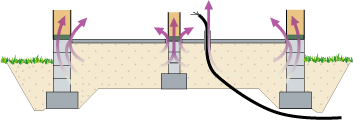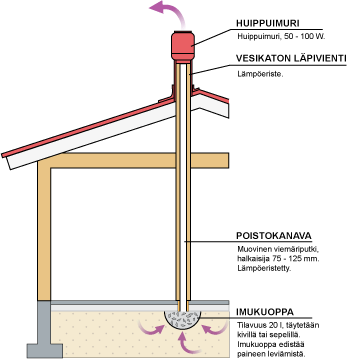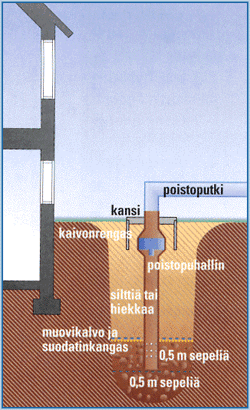Radon mitigation
Radon mitigation can easily reduce radon concentration in indoor air. The most effective mitigation methods are sub-slab suction and a radon well. Before starting the mitigation, it is important to check that the ventilation is working well enough, as poorly functioning ventilation increases the radon concentration. Sealing can also reduce radon concentration, but it can be very challenging to carry out, especially in wooden houses.
More detailed information on radon mitigation can be found in the radon mitigation guide: Asuntojen radonkorjaaminen (Radon mitigation of dwellings, in Finnish only) (Julkari.fi). The guide is suitable for planning radon mitigation for all buildings. More detailed instructions are also provided by the municipal building supervision.
You can select English subtitles for the video from the wheel icon.
When deciding on radon mitigation, it is advisable to do it on the basis of reliable radon measurements that have lasted at least two months. Shorter radon measurements are affected by random variation in radon concentrations due to weather fluctuations.
You can ask about radon mitigation from HVAC stores and companies that carry out radon mitigation.
Companies offering radon mitigation services (stuk.fi, in Finnish only).
Finally, the success of the mitigation is checked with a new alpha track detector measurement that is at least two months long and carried out during the measurement period, i.e. between September and May.
Methods for radon mitigation
The most common cause of elevated radon concentrations in indoor air is the soil under the building. Other reasons may include poorly/improperly functioning ventilation, bore well water or building materials.
From the soil, radon can be carried inside by air currents. The air flow is created by the underpressure in the building, which in turn is created by the mechanical ventilation and the temperature difference between the outdoor and indoor air. The most common leakage route is the gap between the ground-supported floor slab and the footing/wall, which is created as the concrete dries and shrinks.

If radon piping is installed under the floor slab during the construction phase, it is usually easy to reduce the radon concentration by connecting an extractor fan to the radon pipeline vent pipe. Typically, activation reduces radon concentration by 70–90%.
Sub-slab suction sucks air from under the floor slab. Sub-slab suction can be implemented either through a floor slab or footing. Sub-slab suction through the floor is implemented by making a 20–30 litre suction pit under the slab (suction point). An exhaust duct is led from the suction pit to the roof, where the extractor fan is placed. The underpressure developed under the slab and the ventilation effect efficiently reduce the flow of radon into the house. Sub-slab suction usually reduces the radon concentration by 60–90 per cent.
With one suction point, it is possible to repair even a space of 120 m2, if the house has a monolith slab. The suction point is placed as centrally as possible in the space to be mitigated. If necessary, several suction points must be built. The advantage of sub-slab suction implemented through the footing is that no repair work is needed indoors. On the other hand, one suction point through the footing is not necessarily enough. The air removed by the sub-slab suction contains a lot of radon, so the air must be blown far away from the air vents, air intake points, ventilation windows, terraces and other living areas. The best place for the extractor fan is on the roof.

Rated values have been assigned to the air sucked from soil, limiting possible problems caused by cold air. The rated values can be found in the radon mitigation guide. The area of the ground-supported walls is also taken into account in the dimensioning.
The price of sub-slab suction installed by a company is approximately EUR 3,000–5,000. Most of the costs come from the share of work. Sub-slab suction parts typically cost a few hundred euros.
The most common problem observed in radon mitigation was that a harmful amount of ice accumulation has been observed in sub-slab suction systems. If enough ice accumulates in the extractor to make it stop, the radon concentration in indoor air rises to the original high level. Therefore, the functioning of the sub-slab suction system should be monitored, particularly during long periods of very cold weather, or if a lot of snow accumulates on the roof. Electronic alarm systems are available for the monitoring of the suction system.
A radon well sucks air from the soil from outside the building, which reduces the radon concentration in the soil air and creates an air flow under the house that slows down the movement of radon. Radon wells are suitable only for coarse gravel and sand, in which the flow field created by the well can progress under the house being repaired.
In a row house unit, one radon well can help fix the radon concentration of as many as ten dwelling units.
Radon wells are built outside the house, a few metres from the building. They should be 4–5 metres deep. The total cost of a radon well is approximately EUR 4,000–6,000.
A radon well is usually very efficient. It reduces radon concentration by 70–95% on average.


There are several measures related to ventilation to be taken to improve the radon concentration: installation of supply-air vents, improvement of ventilation, balancing of mechanical supply or exhaust ventilation and cleaning of ducts. However, these measures have only in exceptional cases led to a higher than 50% reduction in radon concentrations. Ventilation repairs are most helpful in areas where ventilation has been poor during the first measurement.
Clogged ventilation filters reduce ventilation and increase underpressure in the building. Filters should be replaced regularly in accordance with the instructions of the ventilation unit or valve manufacturer.
In buildings with mechanical exhaust air ventilation, the underpressure is considerably higher compared with buildings with natural ventilation or mechanical supply and exhaust ventilation. Underpressure increases currents of radon-bearing air from the soil. Problems caused by underpressure are most significant when the wall and roof structures are tight, for example, in concrete element buildings.
Adding supply-air vents decreases the underpressure of the building.
Adding supply-air vents costs a few hundreds of euros, while the installation of a new mechanical supply and exhaust air device is the most expensive one (approximately EUR 10,000 or more). Therefore, the installation of a new mechanical supply and exhaust ventilation unit is usually justified only if the intention is also to improve indoor air quality and/or energy efficiency through heat recovery. The benefits of the installation of mechanical exhaust ventilation are modest on average, and sometimes the radon concentration may even increase
By sealing ground-supported structures and connections, currents of radon-containing air from the soil into the building can be reduced. However, it may be difficult to detect and seal all possible leakage points.
According to surveys, in low-rise residential buildings with wooden load-bearing wall structures, sealing has usually reduced the radon concentration by 10–20 per cent. When combined with improved efficiency of ventilation, the radon concentration has fallen by 20–40 per cent. Concrete-framed buildings have achieved better results through sealing: radon concentration typically decreases by 30–60 per cent.
Polyurethane-based elastic joint sealing compounds as well as adhesive and waterproofing compounds can be used for sealing the gap between the floor slab and footing. The manufacturer’s instructions must be followed. Widening of gaps and cleaning of the area of adhesion are important parts of the work. The seals must be made against concrete surfaces.
The cost of sealing varies greatly. The most significant cost items are preparation work (structural openings) and actual sealing work as well as the replacement of surface materials.
High radon concentrations are commonly detected in ground floor flats with the floor in direct contact with the ground. Radon-containing air can access higher floors through pipe ducts, but such findings are not very common. Underpressure management is emphasized in the radon mitigation of apartment buildings due to the dense wall structures.
The radon mitigation methods used in low-rise residential buildings and apartment buildings are also applicable to workplaces. A suitable mitigation method or a combination of them is selected on a case-by-case basis. The most significant differences are the large floor area of the buildings and the ventilation systems used.
During working hours at workplaces and in public buildings, the air exchange rate is normally set much higher than in dwellings. At night and on weekends, ventilation is usually on minimum power or completely off. This affects the variation of radon concentrations and the interpretation of measurement results. If the building has timed ventilation and the radon concentration measured with alpha track detectors for at least two months is higher than the reference value, it is advisable to carry out a one-week continuous radon measurement before the actual radon mitigation to determine the day-night variation. In some cases, it has been possible to reduce the radon concentration during working hours to below the reference value by bringing forward the start of ventilation. In most premises, increasing ventilation two hours before the start of the workday has proven sufficient.
Read more: Radon concentration during working hours
The ground-level floor structures of large buildings are often composed of several separate slabs, with seams that increase leaks of radon-containing air. Sub-slab drainage systems can also be significant radon-containing air leakage routes.
When using sub-slab suction at workplaces, the typical method is to set up several suction points that can be connected to one or more exhaust fans. In some cases, it can be useful to measure the underpressure under the floor at different parts of the building.
Radon wells are usually suitable for radon mitigation in large buildings built on gravel. Several radon wells can be installed around large buildings. The best location for a radon well is in the middle of the long wall of the building and on the upper side if the building is located on a slope.
Do you have questions about radon mitigation?
In matters relating to radon mitigation in dwellings, please first contact the mitigation companies, municipal building control or health protection authority.
In matters relating to radon mitigation at workplaces, please contact mitigation companies first.
Companies offering radon mitigation services
STUK does not comment on the qualifications of the companies on the list or the quality of their services. STUK is not responsible for the accuracy of the contact information or the completeness of the list. The companies' brochures and websites may contain outdated or incorrect information.
The list of companies offering radon mitigation (stuk.fi, in Finnish only)
[email protected]